In late July, we co-released a report that proposed a targeted subsidized employment program aimed at finding jobs for those disconnected from the workforce in Appalachia. Specifically, the report explored the large number of prime-age workers – those between ages 25 and 54 – that are not included in the formal labor force and not counted as unemployed. The report found that if prime-age people in the 193 Appalachian counties of Kentucky, Ohio, Pennsylvania, and West Virginia were employed at the same rate as the nation, an estimated 206,000 more people would be employed, adding $6.4 billion more in wages to the economy.
While the unemployment rate across Appalachia is relatively low in most places, this gives a false impression that Appalachia has a healthy economy and labor market. The truth is the region has struggled for decades to build a diverse and robust economy, resulting in a paucity of jobs causing people to drop out of the workforce or seek remuneration in the informal economy. The purpose of this post is to explore in greater detail the large number of people in Appalachia that are not included in the labor force, the potential reasons and causes for the region’s low labor force participation, and why closing this employment gap is crucial to building shared prosperity in the region.
The Unemployed: Who’s in, Who’s Out?
While many people may think that anyone without a job is “unemployed,” that’s not how the official statistics work.
The first step to understanding the unemployment rate is to look at the universe of people who are included in the labor force, which is the unemployed plus the employed. The US Bureau of Labor Statistics (BLS) begins by estimating the civilian noninstitutional population age 16 and older (diagram delow). This is the potential workforce. It excludes people who are active members in the US Armed Forces and people confined to correctional institutions or living in residential care facilities like nursing homes. The labor force is made up of those that are employed or unemployed. To be counted as employed you are either a paid employee, self-employed, or work for a family business (at least 15 hours). Volunteer work, unpaid internships or training programs, jury duty, or working around one’s home are not considered employment. To be unemployed, you must be not working but available for work and actively looking for work in the last 4 weeks or be expecting to be recalled back to work.
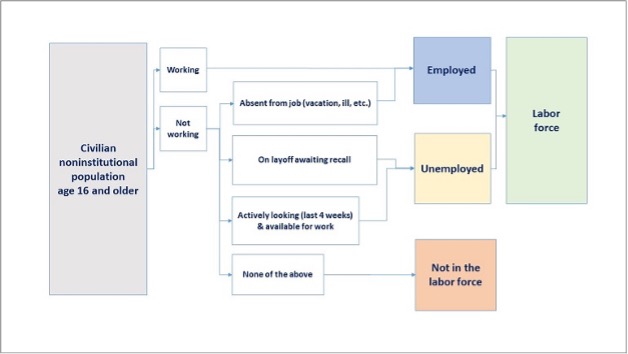
Source: US Bureau of Labor Statistics
Table 1: Labor Force, Employment, and Unemployment in Ohio River Valley States, 2022
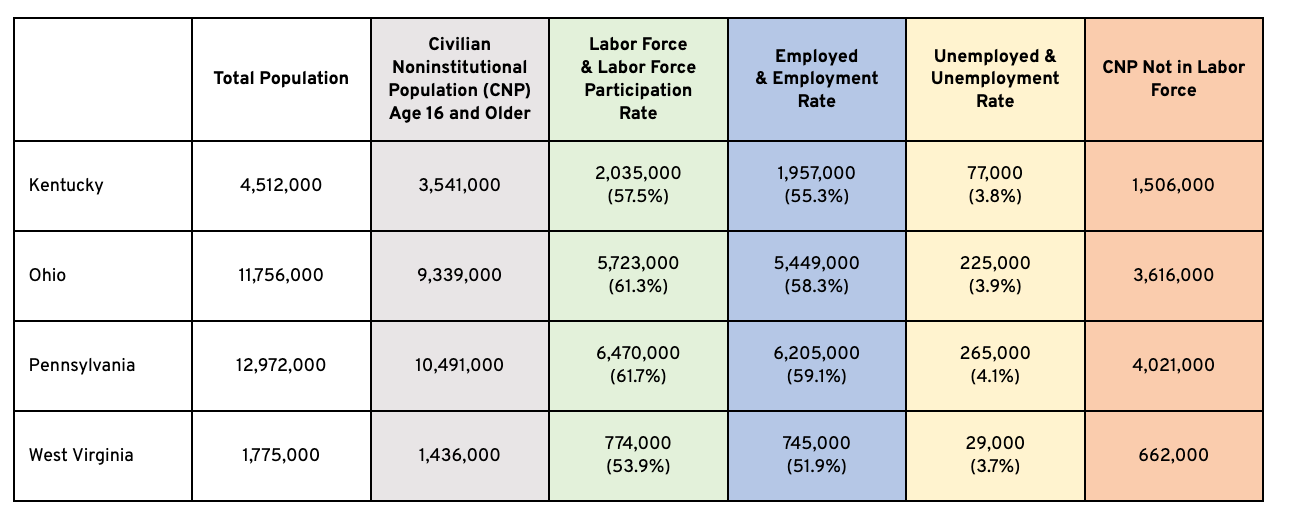
Source: US Bureau of Labor Statistics, Local Area Unemployment Statistics, 2022 Annual Averages
Table 1 above shows the number of people in each color-coded category in the diagram above for the four Ohio River Valley states. The table includes the information needed to calculate rates of unemployment, employment, and labor force participation for 2022. For example, the unemployment rate in West Virginia was 3.7 percent in 2022. The unemployment rate is found by dividing the number of unemployed (29,000) by the labor force (774,000) multiplied by 100. The employment rate or employment-to-population ratio in West Virginia is 52 percent, which is the number of employed (745,000) divided by the civilian noninstitutional population (1,436,000) multiplied by 100. The labor force participation rate is the share of West Virginia’s population in the civilian noninstitutional population (1,436,000) in the labor force (774,000), which is 54 percent.
Also included in Table 1 is the number of people in the civilian noninstitutional population that are not in the labor force (orange) in the four states. These folks are neither employed nor unemployed, according to the Bureau of Labor Statistics. Diagram 2 below highlights two paths for those not in the labor force. Either they want a job now – referred to as “marginally attached” – and have looked for work in the last 12 months but not the last four weeks or do not want a job now either because they haven’t searched for a job in the last 12 months, or they are not available for work. A subset of “marginally attached” are “discouraged workers” that believe no job is available for a variety of reasons.
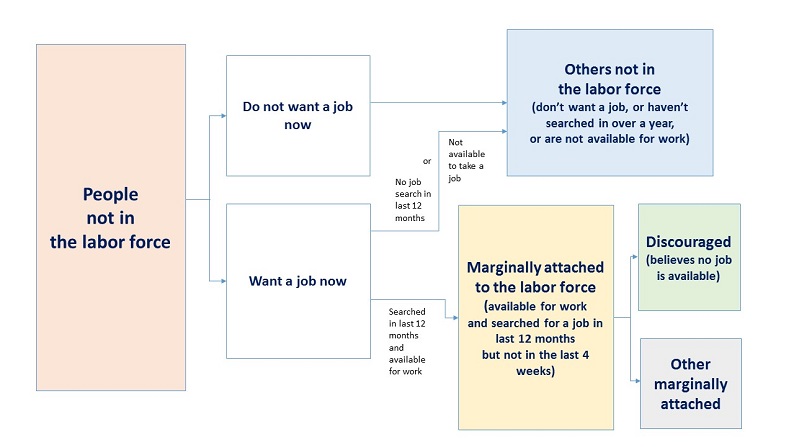
Source: US Bureau of Labor Statistics
Table 2 below takes a closer look at the “marginally attached,” or the population not in the labor force but wanting a job, over the last six months using monthly data from the Current Population Survey (CPS). Altogether, the number of people marginally attached to the workforce (but not included in the labor force) in the four states is around 490,000 and is close to the same number of people that are officially counted as “unemployed”. Therefore, including the marginally attached as “unemployed” nearly doubles the number of people who want a job but do not have one.
Table 2: Marginally Attached and Labor Force in Ohio River Valley States, January-July 2023
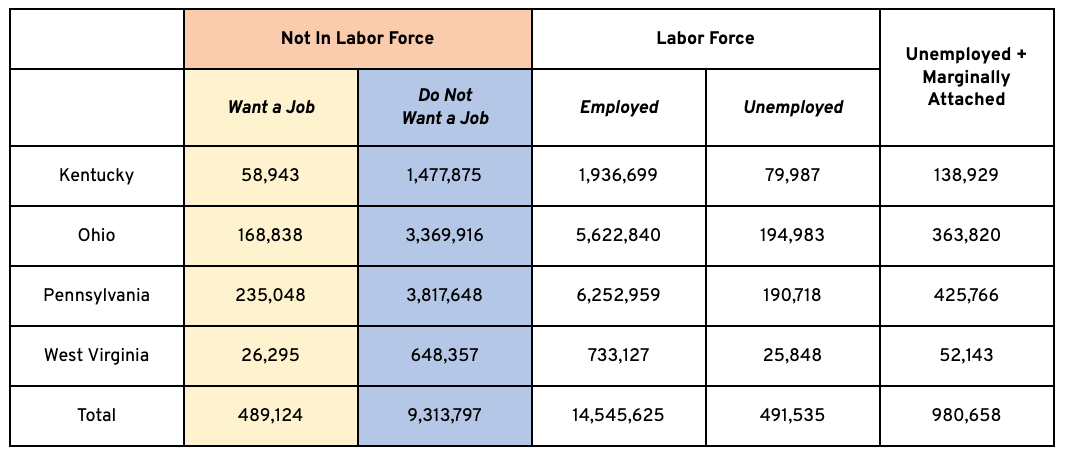
Source: Current Population Survey Basic Monthly, Non-Seasonally Adjusted
As noted above, the official number of unemployed excludes certain jobless groups, such as those marginally attached to the workforce and discouraged workers. The US Bureau of Labor Statistics also publishes six “Alternative Measures of Labor Underutilization for States” on a quarterly basis (using 12-month rolling averages) that not only include those marginally attached but also those seeking full-time work but can only find part-time work. This latter measure, part-time for economic reasons, includes people that are officially part of the labor force. Table 3 below shows the total jobs needed in the four Ohio River Valley region states that include those who want full-time work but can only find part-time because of slack work or unfavorable business conditions, inability to find full-time work, or seasonal declines in demand. Altogether, there are about 1.2 million people that would like to work full-time but are not able to do so in the Ohio River Valley states.
Table 3: Total Jobs Needed in Ohio River Valley States, January-July 2023
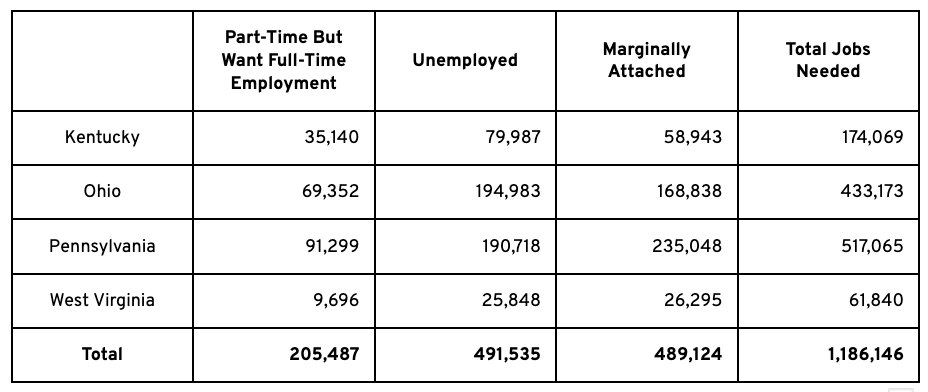
Source: Current Population Survey Basic Monthly
What about those not in the labor force?
While we know there is a slice of people not in the labor force because they have given up looking for work but want to work (marginally attached), most people not in the labor force are enrolled in school/college, retired, taking care of a family member, disabled or ill, or a few other reasons. A 2015 report that I co-authored explored the reasons for West Virginia’s (the only state completely in Appalachia) ultra-low labor force participation rates, finding that old age, poor health, low educational attainment, and the state’s large disabled population were primary factors. Other possible reasons could be the larger presence of informal employment and nonstandard work in Appalachia due to the higher rates of poverty and fewer job opportunities. A paper by economists at West Virginia University points to an unknown “Appalachia effect” that is partially responsible for the region’s low labor force participation along with a lack of economic diversity and human capital.
As we highlighted in our recent report, the working age population in Central Appalachia has higher rates of disability compared to the nation coupled with a smaller share that are employed. Nationally, about 10 percent of working age people (18 to 64) have a disability, compared to 19 percent in the Appalachian counties of Kentucky and West Virginia. In some counties in the coalfields of Central Appalachia, over one-third of the population has a disability. Like the low labor force participation rates in the region, this is mostly driven by low educational attainment, poor health outcomes, a large share of physically demanding jobs (e.g., coal mining) resulting in workplace injuries, and less job opportunities. In West Virginia, only about 28 percent of working age people with a disability ages 18 to 64 are employed compared to 37 percent nationally.
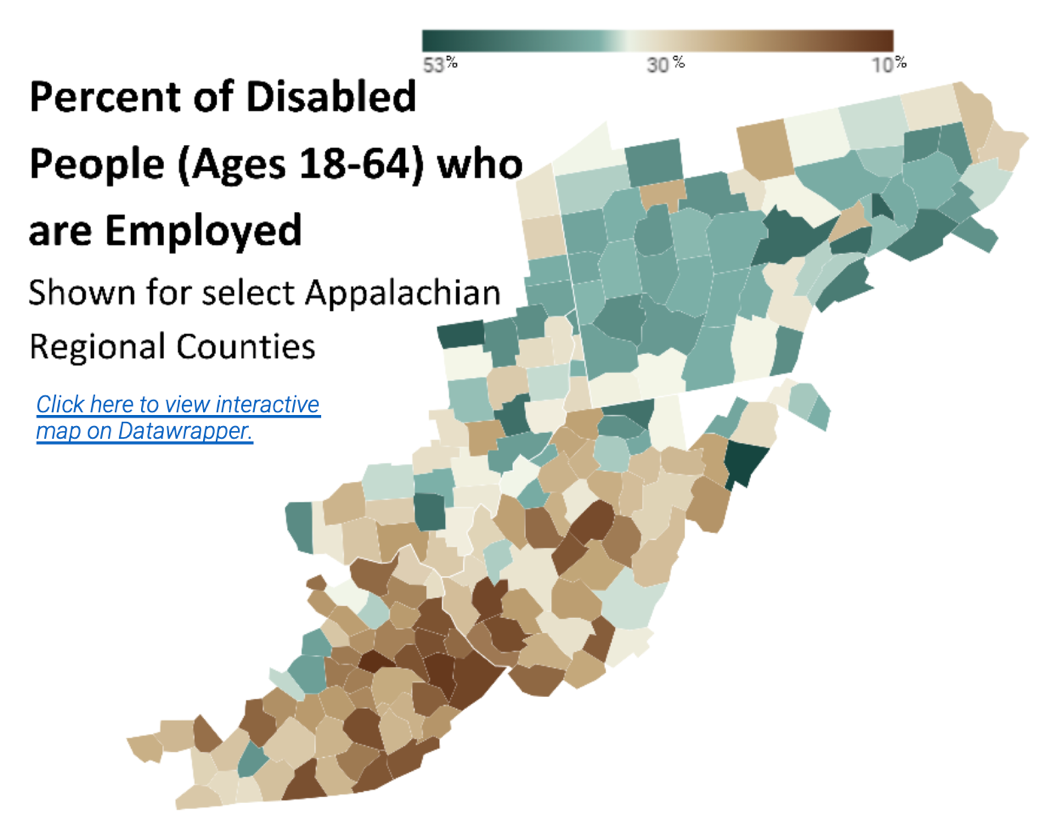
Source: Targeted Employment: Reconnecting Appalachia’s Disconnected Workforce
Note: Click here to view interactive map on Datawrapper.
Another way to illustrate how the region’s low labor force participation rates mask its relatively low unemployment rate is by looking at how many additional people could be in the labor force. The table below uses data compiled by the Appalachian Regional Commission (5-Year American Community Survey) to explore labor force participation in the 193 Appalachian counties in Kentucky, Ohio, Pennsylvania, and West Virginia. It only includes those between ages 25 and 64, which helps isolate the working age population and exclude people that are retired or going to school. If these counties had the same labor force participation rate as the national average of 78.3 percent, there would be an additional 298,000 people in the labor force. If these additional people were counted as unemployed, the rate in the Appalachian counties would more than double, from 4.7 percent to over 11 percent. The biggest jump in the unemployment rate would be in Kentucky and West Virginia, where the rates would be three and a half to five times the official unemployment rates for the state.
Table 4: Unemployment Based on US Labor Force Participation Rate, 2017-2021

Source: Appalachian Regional Commission
Closing the Unemployment Gap in Appalachia
As this post has shown, there is a significant gap in the number of people left out of the workforce that could potentially be employed in Appalachia. Many of these people face stiff barriers to work and are disconnected to the workforce or just marginally attached. Drastically increasing the labor force participation of prime-age people in the region should be a top priority for policymakers. It will take working closely with people in the disabled population, boosting jobs in regions with severe economic distress, and making investments in the health and wellbeing of communities that have been left behind. This could include enacting a national subsidized employment program as outlined in our report, revamping the Civilian Conservation Corps, utilizing federal funding opportunities like the Recompete Pilot Program, ARC POWER Grants, funding from the Interagency Working Group on Coal & Power Plant Communities & Economic Revitalization, and funds included in the Inflation Reduction Act.

